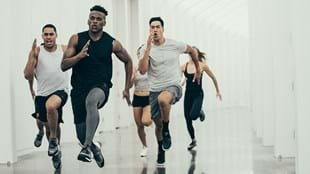The theory behind compression clothing is that it helps blood flow through the muscles in the part of the body wearing the garment (i.e. if you’re wearing compression tights it will help blood flow through the legs). This means that oxygen (and other fuels for exercise, such as carbohydrates) can get to the muscle quicker, and the waste products (such as lactic acid) can be taken away from the muscle with more haste.
Several scientific studies have attempted to prove these theories, and have come up with some interesting results; here’s what the science tells us about the benefits of compression garments:
1. They aid post-training recovery
A recent review has shown that compression garments can aid recovery, regardless of how much pressure the garment puts on to the body. They found that people performed better the next day after wearing a compression garment compared to no compression. Strength training had the largest improvements in recovery, with slightly smaller recovery benefits (but still more than wearing no compression) for cycling-based exercise, and recovery benefits that were slightly smaller again for cardio-based exercise.
2. They don’t affect performance during a training session/match
Although there are some individual studies that have suggested small improvements in performance, the clear majority say that there is no improvement in performance when wearing compression garments while training.
3. They reduce DOMS
DOMS (delayed onset muscle soreness) is the achy feeling you get after training, and it usually presents between eight hours and two days after a training session. Compression garments have been shown to reduce these feelings of soreness. A variety of studies have shown that wearing compression garments after a training session will hugely reduce the feelings of soreness, whether it is strength training, sprint training (which is similar in nature to HIIT) or a sports-specific-combination of cardio and strength training.
4. It doesn’t matter if you’re new to exercise or not
The benefits of compression garments were seen for both regular exercisers, and those new to exercise – indicating that donning compression clothing can be advantageous for all exercisers, not just elite athletes.
5. It makes your skin hotter
Every study that has measured temperature and compression garments has shown that wearing them makes your skin hotter. This is hardly surprising, but worth considering if you are recovering in a hot environment.
THE BOTTOM LINE
The evidence suggests that wearing compression garments while training does not affect performance. However, wearing compression garments for up to 24 hours after training seems to speed up recovery and decrease the feelings of soreness. This is particularly useful if you are training multiple times per week.
If you’re keen to add some compression garments to your wardrobe check out Reebok.com
Want to learn more?
David Cox has also been reviewing the research underpinning the compression clothing scene. Listen to what he has to say on the topic here:
This interview comes courtesy of Radio New Zealand.

Mike Trott is a UK-based fitness professional who specializes in sports personality psychology and sports exercise physiology. He has conducted academic research into group exercise interventions and personality, exercise addiction, and foam rolling physiology, and is also a multi-award-winning Les Mills instructor, trainer and presenter.
If you want more health and fitness inspiration simply sign up to Fit Planet and get the freshest insights and advice straight to your inbox.



